THEMIS Vector Magnetograph in Canary Islands
Abstract
1. Introduction
2. THEMIS Between 1998–2014
2.1. Instrument
2.2. Inversion Method—Zeeman Effect
2.3. Inversion Method—Hanle Effect
3. Science in Progress
3.1. Second Solar Spectrum
3.2. Active Regions
3.2.1. Maps
3.2.2. Magnetic Configuration
3.2.3. Triggering Mechanisms of Eruptions
3.3. Filaments
3.4. Prominences
3.5. Plasma Threads in Prominence
4. THEMIS After 2019
4.1. New Generation Instrument
4.2. Spectroscopy and Imaging
4.2.1. Imaging
4.2.2. Spectroscopy
4.3. Polarimeter
5. Conclusions
Funding
Data Availability Statement
Acknowledgments
Conflicts of Interest
References
- Arnaud, J.; Mein, P.; Rayrole, J. The Solar Telescope THEMIS. In Proceedings of the Crossroads for European Solar and Heliospheric Physics. Recent Achievements and Future Mission Possibilities; Priest, E.R., Ed.; ESA Special Publication: Noordwijk, The Netherlands, 1998; Volume 417, p. 213. [Google Scholar]
- Mein, P. High resolution observations with THEMIS: Prospects in magnetic field observations. In Proceedings of the High Spatial Resolution Solar Observations, Sunspot, MN, USA, 22–26 August 1988; von der Luehe, O., Ed.; National Solar Observatory: Sunspot, MN, USA, 1989; p. 12. [Google Scholar]
- Mein, P.; Malherbe, J.M.; Sayède, F.; Rudawy, P.; Phillips, K.J.H.; Keenan, F.P. Four Decades of Advances from MSDP to S4I and SLED Imaging Spectrometers. Sol. Phys. 2021, 296, 30. [Google Scholar] [CrossRef]
- Rayrole, J. The new solar magnetograph for the Canary Islands Observatory THEMIS. In Proceedings of the NASA Conference Publication, Monterey, CA, USA, 22–24 July 1985; NASA Conference Publication: Hanover, MD, USA, 1985; Volume 2374, pp. 219–230. [Google Scholar]
- Gelly, B.; Le Men, C.; López Ariste, A.; Delaigue, C.; Gónzalez Perez, R. Design and implementation of an image stabilization device at the THEMIS solar telescope. Exp. Astron. 2008, 22, 67–85. [Google Scholar] [CrossRef]
- Bommier, V.; Rayrole, J. Search for polarimetric sensitivity in the first observations with THEMIS spectropolarimetric mode MTR (August 1998 campaign). Astron. Astrophys. 2002, 381, 227–240. [Google Scholar] [CrossRef]
- Landi Degl’Innocenti, E.; Landolfi, M. Polarization in Spectral Lines; Springer: Berlin/Heidelberg, Germany, 2004; Volume 307. [Google Scholar] [CrossRef]
- Bommier, V.; Landi Degl’Innocenti, E.; Landolfi, M.; Molodij, G. UNNOFIT inversion of spectro-polarimetric maps observed with THEMIS. Astron. Astrophys. 2007, 464, 323–339. [Google Scholar] [CrossRef]
- Landolfi, M.; Landi Degl’Innocenti, E.; Arena, P. On the Diagnostic of Magnetic Fields in Sunspots Through the Interpretation of Stoke’s Parameters Profiles. Sol. Phys. 1984, 93, 269–287. [Google Scholar] [CrossRef]
- Bommier, V. Magnetometry: Solving the fundamental ambiguity from line pair inversion. Astron. Astrophys. 2025, 694, A40. [Google Scholar] [CrossRef]
- Faurobert, M.; Aime, C.; Périni, C.; Uitenbroek, H.; Grec, C.; Arnaud, J.; Ricort, G. Direct measurement of the formation height difference of the 630 nm Fe I solar lines. Astron. Astrophys. 2009, 507, L29–L32. [Google Scholar] [CrossRef]
- Metcalf, T.R. Resolving the 180-degree ambiguity in vector magnetic field measurements: The ‘minimum’ energy solution. Sol. Phys. 1994, 155, 235–242. [Google Scholar] [CrossRef]
- Leroy, J.L.; Bommier, V.; Sahal-Brechot, S. The Magnetic Field in the Prominences of the Polar Crown. Sol. Phys. 1983, 83, 135–142. [Google Scholar] [CrossRef]
- Bommier, V.; Sahal-Brechot, S.; Leroy, J.L. The linear polarization of hydrogen H-beta radiation and the joint diagnostic of magnetic field vector and electron density in quiescent prominences. I. The magnetic field. Astron. Astrophys. 1986, 156, 79–89. [Google Scholar]
- Bommier, V.; Landi Degl’Innocenti, E.; Leroy, J.L.; Sahal-Brechot, S. Complete determination of the magnetic field vector and of the electron density in 14 prominences from linear polarizaton measurements in the HeI D3 and Hα lines. Sol. Phys. 1994, 154, 231–260. [Google Scholar] [CrossRef]
- Bommier, V.; Leroy, J.L.; Sahal-Bréchot, S. 24 synoptic maps of average magnetic field in 296 prominences measured by the Hanle effect during the ascending phase of solar cycle 21. Astron. Astrophys. 2021, 647, A60. [Google Scholar] [CrossRef]
- Sahal-Brechot, S.; Bommier, V.; Feautrier, N. Doppler redistribution of anisotropic radiation and resonance polarization in moving scattering media. I. Theory revisited in the density matrix formalism. Astron. Astrophys. 1998, 340, 579–592. [Google Scholar]
- Bommier, V.; Leroy, J.L. Global Pattern of the Magnetic Field Vectors Above Neutral Lines from 1974 to 1982: Pic-du-Midi Observations of Prominences. In Proceedings of the IAU Colloq. 167: New Perspectives on Solar Prominences, Aussois, France, 28 April–4 May 1997; Webb, D.F., Schmieder, B., Rust, D.M., Eds.; Astronomical Society of the Pacific Conference Series. 1998; Volume 150, p. 434. [Google Scholar]
- Leroy, J.L.; Bommier, V.; Sahal-Brechot, S. New data on the magnetic structure of quiescent prominences. Astron. Astrophys. 1984, 131, 33–44. [Google Scholar]
- Kalewicz, T.; Bommier, V. Magnetic field vector ambiguity resolution in a quiescent prominence observed on two consecutive days. Astron. Astrophys. 2019, 629, A138. [Google Scholar] [CrossRef]
- López Ariste, A.; Casini, R. Magnetic Fields in Prominences: Inversion Techniques for Spectropolarimetric Data of the He I D3 Line. Astrophys. J. 2002, 575, 529–541. [Google Scholar] [CrossRef]
- Casini, R.; Bevilacqua, R.; López Ariste, A. Principal Component Analysis of the He I D3 Polarization Profiles from Solar Prominences. Astrophys. J. 2005, 622, 1265–1274. [Google Scholar] [CrossRef]
- Asensio Ramos, A.; Trujillo Bueno, J.; Landi Degl’Innocenti, E. Advanced Forward Modeling and Inversion of Stokes Profiles Resulting from the Joint Action of the Hanle and Zeeman Effects. Astrophys. J. 2008, 683, 542–565. [Google Scholar] [CrossRef]
- Faurobert, M.; Arnaud, J.; Vigneau, J.; Frisch, H. Investigation of weak solar magnetic fields. New observational results for the SrI 460.7 nm linear polarization and radiative transfer modeling. Astron. Astrophys. 2001, 378, 627–634. [Google Scholar] [CrossRef]
- Faurobert, M.; Arnaud, J. Center-to-limb variation of scattering polarization in molecular solar lines: Observations and modeling. Astron. Astrophys. 2003, 412, 555–565. [Google Scholar] [CrossRef]
- Bommier, V.; Landi Degl’Innocenti, E.; Feautrier, N.; Molodij, G. Collisional influence on the differential Hanle effect method applied to the second solar spectrum of the A2Π-X2Σ+ (0, 0) band of MgH. Astron. Astrophys. 2006, 458, 625–633. [Google Scholar] [CrossRef]
- Faurobert, M.; Derouich, M.; Bommier, V.; Arnaud, J. Hanle effect in the solar Ba II D2 line: A diagnostic tool for chromospheric weak magnetic fields. Astron. Astrophys. 2009, 493, 201–206. [Google Scholar] [CrossRef]
- Faurobert, M.; Ricort, G. Solar-cycle variations of the internetwork magnetic field. Astron. Astrophys. 2015, 582, A95. [Google Scholar] [CrossRef]
- Schmieder, B.; Mein, P.; Simnett, G.M.; Tandberg-Hanssen, E. An example of the association of X-ray and UV emission with H-alpha surges. Astron. Astrophys. 1988, 201, 327–338. [Google Scholar]
- Pasechnik, M.N. Spectral Study Lower Solar Atmosphere of the Active Region Site with the Ellerman Bomb and Accompanying Hα-EJECTIONS. Odessa Astron. Publ. 2023, 36, 178–182. [Google Scholar] [CrossRef]
- Guo, Y.; Schmieder, B.; Démoulin, P.; Wiegelmann, T.; Aulanier, G.; Török, T.; Bommier, V. Coexisting Flux Rope and Dipped Arcade Sections Along One Solar Filament. Astrophys. J. 2010, 714, 343–354. [Google Scholar] [CrossRef]
- Guo, Y.; Ding, M.D.; Schmieder, B.; Li, H.; Török, T.; Wiegelmann, T. Driving Mechanism and Onset Condition of a Confined Eruption. Astrophys. J. Lett. 2010, 725, L38–L42. [Google Scholar] [CrossRef]
- Török, T.; Kliem, B. Confined and Ejective Eruptions of Kink-unstable Flux Ropes. Astrophys. J. Lett. 2005, 630, L97–L100. [Google Scholar] [CrossRef]
- Kliem, B.; Török, T. Torus Instability. Phys. Rev. Lett. 2006, 96, 255002. [Google Scholar] [CrossRef]
- Canou, A.; Amari, T.; Bommier, V.; Schmieder, B.; Aulanier, G.; Li, H. Evidence for a Pre-Eruptive Twisted Flux Rope Using the Themis Vector Magnetograph. Astrophys. J. Lett. 2009, 693, L27–L30. [Google Scholar] [CrossRef]
- Aulanier, G.; Török, T.; Démoulin, P.; DeLuca, E.E. Formation of Torus-Unstable Flux Ropes and Electric Currents in Erupting Sigmoids. Astrophys. J. 2010, 708, 314–333. [Google Scholar] [CrossRef]
- Guo, J.H.; Ni, Y.W.; Zhou, Y.H.; Guo, Y.; Schmieder, B.; Chen, P.F. Prominence fine structures in weakly twisted and highly twisted magnetic flux ropes. Astron. Astrophys. 2022, 667, A89. [Google Scholar] [CrossRef]
- Guo, J.H.; Ni, Y.W.; Guo, Y.; Xia, C.; Schmieder, B.; Poedts, S.; Zhong, Z.; Zhou, Y.H.; Yu, F.; Chen, P.F. Data-driven Modeling of a Coronal Magnetic Flux Rope: From Birth to Death. Astrophys. J. 2024, 961, 140. [Google Scholar] [CrossRef]
- Schmieder, B.; Guo, J.; Poedts, S. Recent advances in solar data-driven MHD simulations of the formation and evolution of CME flux ropes. Rev. Mod. Plasma Phys. 2024, 8, 27. [Google Scholar] [CrossRef]
- Schmieder, B.; Bommier, V.; Kitai, R.; Matsumoto, T.; Ishii, T.T.; Hagino, M.; Li, H.; Golub, L. Magnetic Causes of the Eruption of a Quiescent Filament. Sol. Phys. 2008, 247, 321–333. [Google Scholar] [CrossRef]
- Xing, C.; Aulanier, G.; Cheng, X.; Xia, C.; Ding, M. Unveiling the Initiation Route of Coronal Mass Ejections through Their Slow Rise Phase. Astrophys. J. 2024, 966, 70. [Google Scholar] [CrossRef]
- Schmieder, B.; Tziotziou, K.; Heinzel, P. Spectroscopic diagnostics of an Hα and EUV filament observed with THEMIS and SOHO. Astron. Astrophys. 2003, 401, 361–375. [Google Scholar] [CrossRef]
- Aulanier, G.; Schmieder, B. The magnetic nature of wide EUV filament channels and their role in the mass loading of CMEs. Astron. Astrophys. 2002, 386, 1106–1122. [Google Scholar] [CrossRef]
- Schmieder, B.; Kucera, T.A.; Knizhnik, K.; Luna, M.; Lopez-Ariste, A.; Toot, D. Propagating Waves Transverse to the Magnetic Field in a Solar Prominence. Astrophys. J. 2013, 777, 108. [Google Scholar] [CrossRef]
- Orozco Suárez, D.; Asensio Ramos, A.; Trujillo Bueno, J. The magnetic field configuration of a solar prominence inferred from spectropolarimetric observations in the He i 10 830 Å triplet. Astron. Astrophys. 2014, 566, A46. [Google Scholar] [CrossRef]
- Levens, P.J.; Schmieder, B.; López Ariste, A.; Labrosse, N.; Dalmasse, K.; Gelly, B. Magnetic Field in Atypical Prominence Structures: Bubble, Tornado, and Eruption. Astrophys. J. 2016, 826, 164. [Google Scholar] [CrossRef]
- Koza, J.; Rybák, J.; Gömöry, P.; Kozák, M.; López Ariste, A. Spectral Characteristics of the He I D3 Line in a Quiescent Prominence Observed by THEMIS. Sol. Phys. 2017, 292, 98. [Google Scholar] [CrossRef]
- Aulanier, G.; Demoulin, P. 3-D magnetic configurations supporting prominences. I. The natural presence of lateral feet. Astron. Astrophys. 1998, 329, 1125–1137. [Google Scholar]
- López Ariste, A.; Aulanier, G. Unveiling the Magnetic Field Topology of Prominences. In Proceedings of the Physics of Chromospheric Plasmas, Coimbra, Portugal, 9–13 October 2006; Heinzel, P., Dorotovič, I., Rutten, R.J., Eds.; Astronomical Society of the Pacific Conference Series. 2007; Volume 368, p. 291. [Google Scholar]
- Schmieder, B.; Tian, H.; Kucera, T.; López Ariste, A.; Mein, N.; Mein, P.; Dalmasse, K.; Golub, L. Open questions on prominences from coordinated observations by IRIS, Hinode, SDO/AIA, THEMIS, and the Meudon/MSDP. Astron. Astrophys. 2014, 569, A85. [Google Scholar] [CrossRef]
- López Ariste, A.; Asensio Ramos, A.; Manso Sainz, R.; Derouich, M.; Gelly, B. Variability of the polarization profiles of the Ba II D{2} line in the solar atmosphere. Astron. Astrophys. 2009, 501, 729–734. [Google Scholar] [CrossRef]
- Casini, R.; López Ariste, A. PCA Inversion of Stokes Profiles in Solar Prominences. In Proceedings of the Solar Polarization, Tenerife, Canary Islands, Spain, 30 September–4 October 2002; Trujillo-Bueno, J., Sanchez Almeida, J., Eds.; Astronomical Society of the Pacific Conference Series. 2003; Volume 307, p. 109. [Google Scholar]
- López Ariste, A.; Casini, R. Inference of the Magnetic Field in Spicules from Spectro-Polarimetry of He I D3. In Proceedings of the Solar Polarization 4, Boulder, CO, USA, 19–23 September 2005; Casini, R., Lites, B.W., Eds.; Astronomical Society of the Pacific Conference Series. 2006; Volume 358, p. 443. [Google Scholar]
- Dudík, J.; Aulanier, G.; Schmieder, B.; Bommier, V.; Roudier, T. Topological Departures from Translational Invariance along a Filament Observed by THEMIS. Sol. Phys. 2008, 248, 29–50. [Google Scholar] [CrossRef]
- Dudík, J.; Aulanier, G.; Schmieder, B.; Zapiór, M.; Heinzel, P. Magnetic Topology of Bubbles in Quiescent Prominences. Astrophys. J. 2012, 761, 9. [Google Scholar] [CrossRef]
- Ariste, A.L. Hanle and Zeeman effects: From solar to stellar diagnostics. In Proceedings of the Magnetic Fields Throughout Stellar Evolution, Biarritz, France, 25–30 August 2013; Petit, P., Jardine, M., Spruit, H.C., Eds.; IAU Symposium. 2014; Volume 302, pp. 130–133. [Google Scholar] [CrossRef]
- Gunár, S.; Labrosse, N.; Luna, M.; Schmieder, B.; Heinzel, P.; Kucera, T.A.; Levens, P.J.; López Ariste, A.; Mackay, D.H.; Zapiór, M. On the Physical Nature of the so-Called Prominence Tornadoes. Space Sci. Rev. 2023, 219, 33. [Google Scholar] [CrossRef]
- Schmieder, B.; Zapiór, M.; López Ariste, A.; Levens, P.; Labrosse, N.; Gravet, R. Reconstruction of a helical prominence in 3D from IRIS spectra and images. Astron. Astrophys. 2017, 606, A30. [Google Scholar] [CrossRef]
- Levens, P.J.; Labrosse, N.; Schmieder, B.; López Ariste, A.; Fletcher, L. Comparing UV/EUV line parameters and magnetic field in a quiescent prominence with tornadoes. Astron. Astrophys. 2017, 607, A16. [Google Scholar] [CrossRef]
- Berger, T.E.; Shine, R.A.; Slater, G.L.; Tarbell, T.D.; Title, A.M.; Okamoto, T.J.; Ichimoto, K.; Katsukawa, Y.; Suematsu, Y.; Tsuneta, S.; et al. Hinode SOT Observations of Solar Quiescent Prominence Dynamics. Astrophys. J. Lett. 2008, 676, L89. [Google Scholar] [CrossRef]
- Zirker, J.B.; Engvold, O.; Martin, S.F. Counter-streaming gas flows in solar prominences as evidence for vertical magnetic fields. Nature 1998, 396, 440–441. [Google Scholar] [CrossRef]
- Xia, C.; Keppens, R. Internal Dynamics of a Twin-layer Solar Prominence. Astrophys. J. Lett. 2016, 825, L29. [Google Scholar] [CrossRef]
- Jenkins, J.M.; Keppens, R. Resolving the solar prominence/filament paradox using the magnetic Rayleigh-Taylor instability. Nat. Astron. 2022, 6, 942–950. [Google Scholar] [CrossRef]
- Gelly, B.; Langlois, M.; Moretto, G.; Douet, R.; Lopez Ariste, A.; Tallon, M.; Thiébaut, E.; Geyskens, N.; Lorgeoux, G.; Léger, J.; et al. New life for the THEMIS solar telescope. In Proceedings of the Ground-Based and Airborne Telescopes VI, Edinburgh, UK, 26 June–1 July 2016; Hall, H.J., Gilmozzi, R., Marshall, H.K., Eds.; Society of Photo-Optical Instrumentation Engineers (SPIE) Conference Series. 2016; Volume 9906, p. 99065. [Google Scholar] [CrossRef]
- Tallon, M.; Thiébaut, É.; Tallon-Bosc, I.; Gelly, B.; Denis, L. Solar wavefront sensing at THEMIS with self-calibrated reference image and estimation of the noise covariance. In Proceedings of the Adaptive Optics Systems VIII, Montreal, QC, Canada, 17–22 July 2022; Schreiber, L., Schmidt, D., Vernet, E., Eds.; Society of Photo-Optical Instrumentation Engineers (SPIE) Conference Series. 2022; Volume 12185, p. 121852. [Google Scholar] [CrossRef]
- Roudier, T.; Malherbe, J.M.; Gelly, B.; Douet, R.; Frank, Z.; Dalmasse, K. Evolution of exploding granules from coordinated observations by THEMIS, IRIS, SDO/HMI, and HINODE, and a simulation. Astron. Astrophys. 2020, 641, A50. [Google Scholar] [CrossRef]
- Karki, G.; Schmieder, B.; Devi, P.; Chandra, R.; Labrosse, N.; Joshi, R.; Gelly, B. Magnetic Reconnection between a Solar Jet and a Filament Channel. Astrophys. J. 2025, 979, 182. [Google Scholar] [CrossRef]

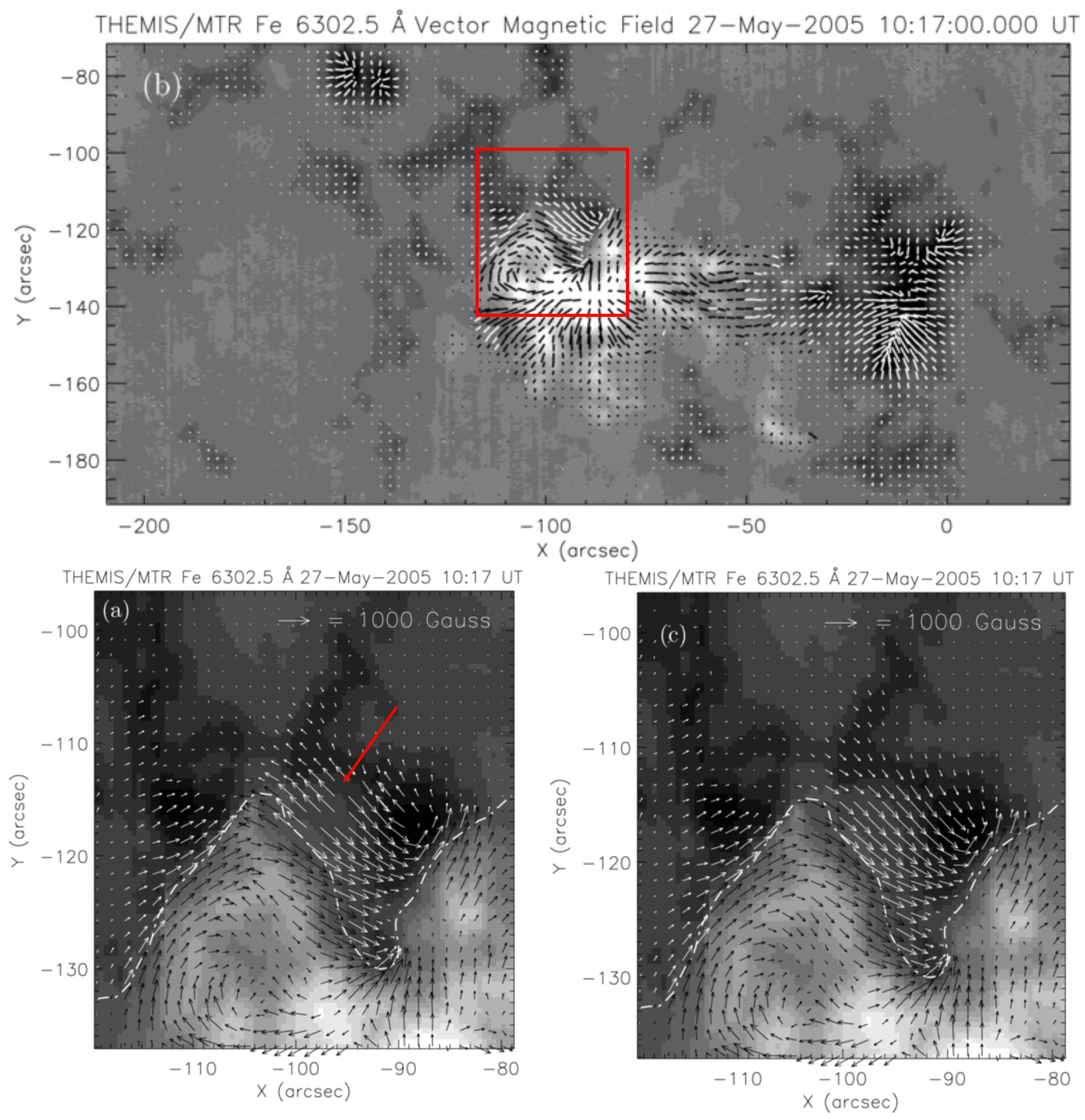
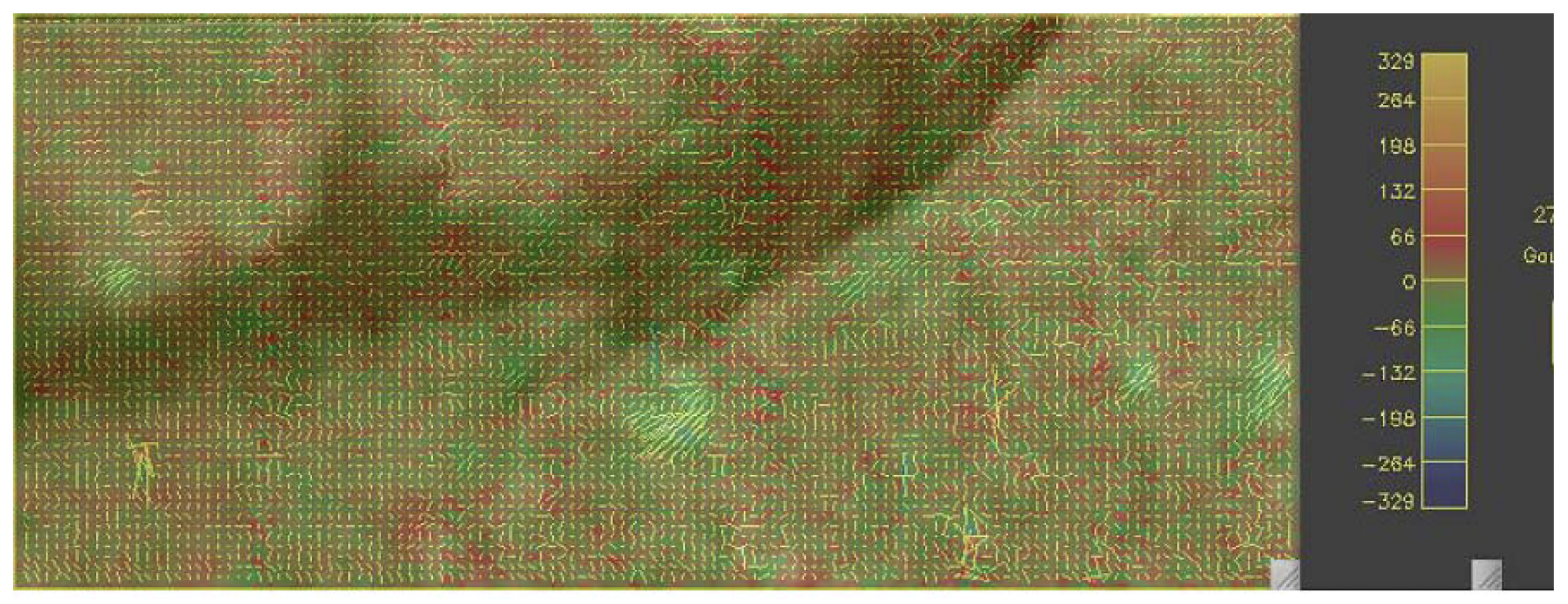
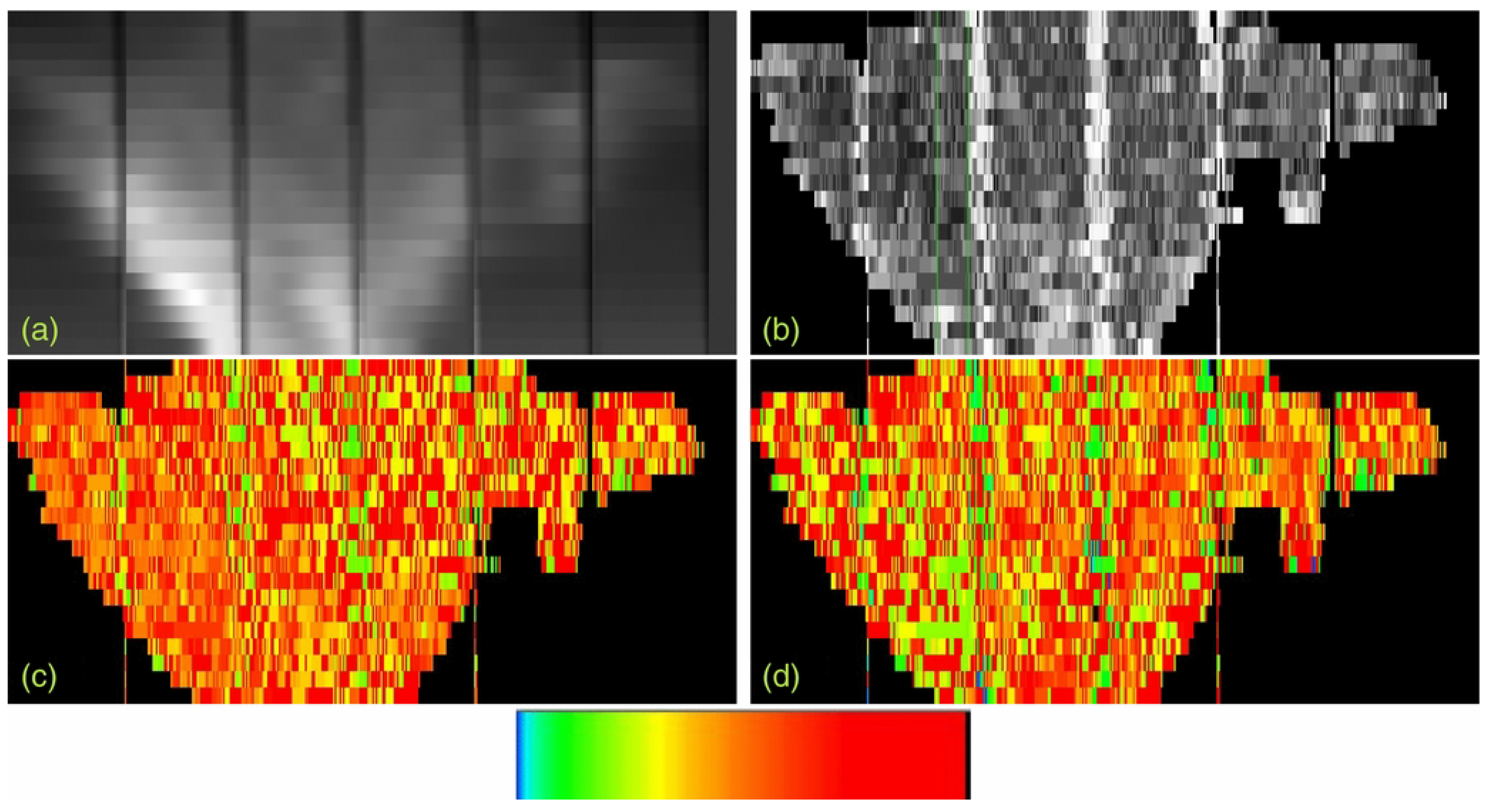
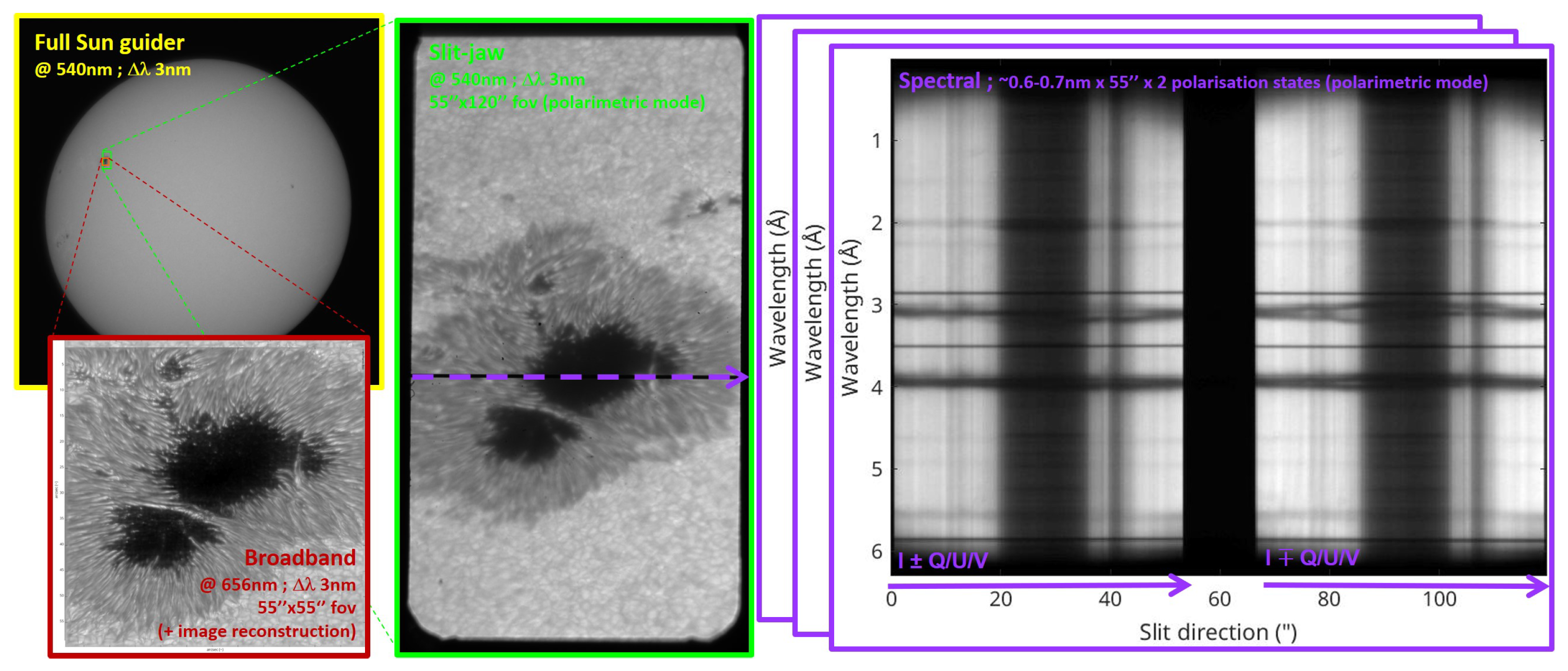
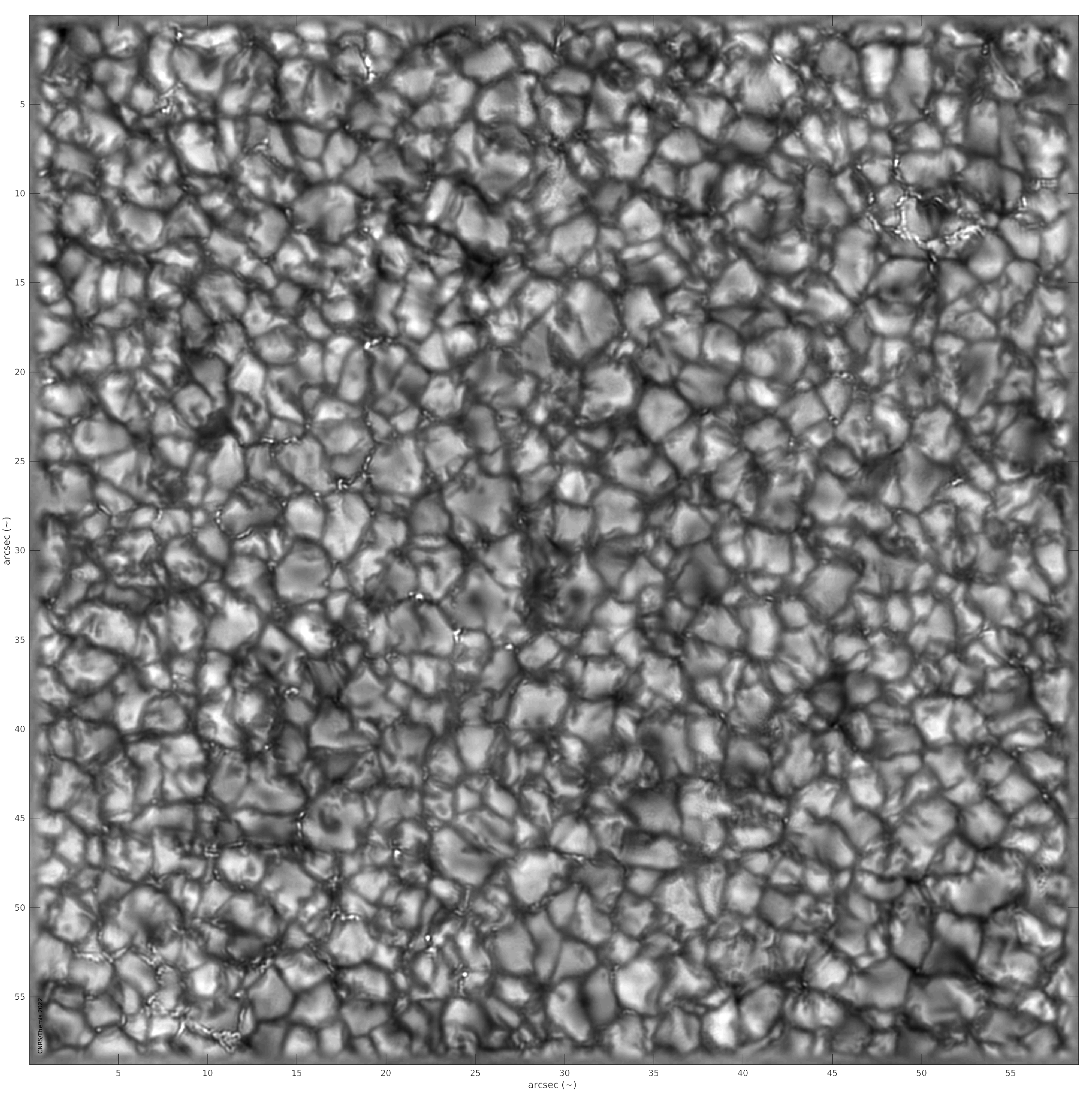

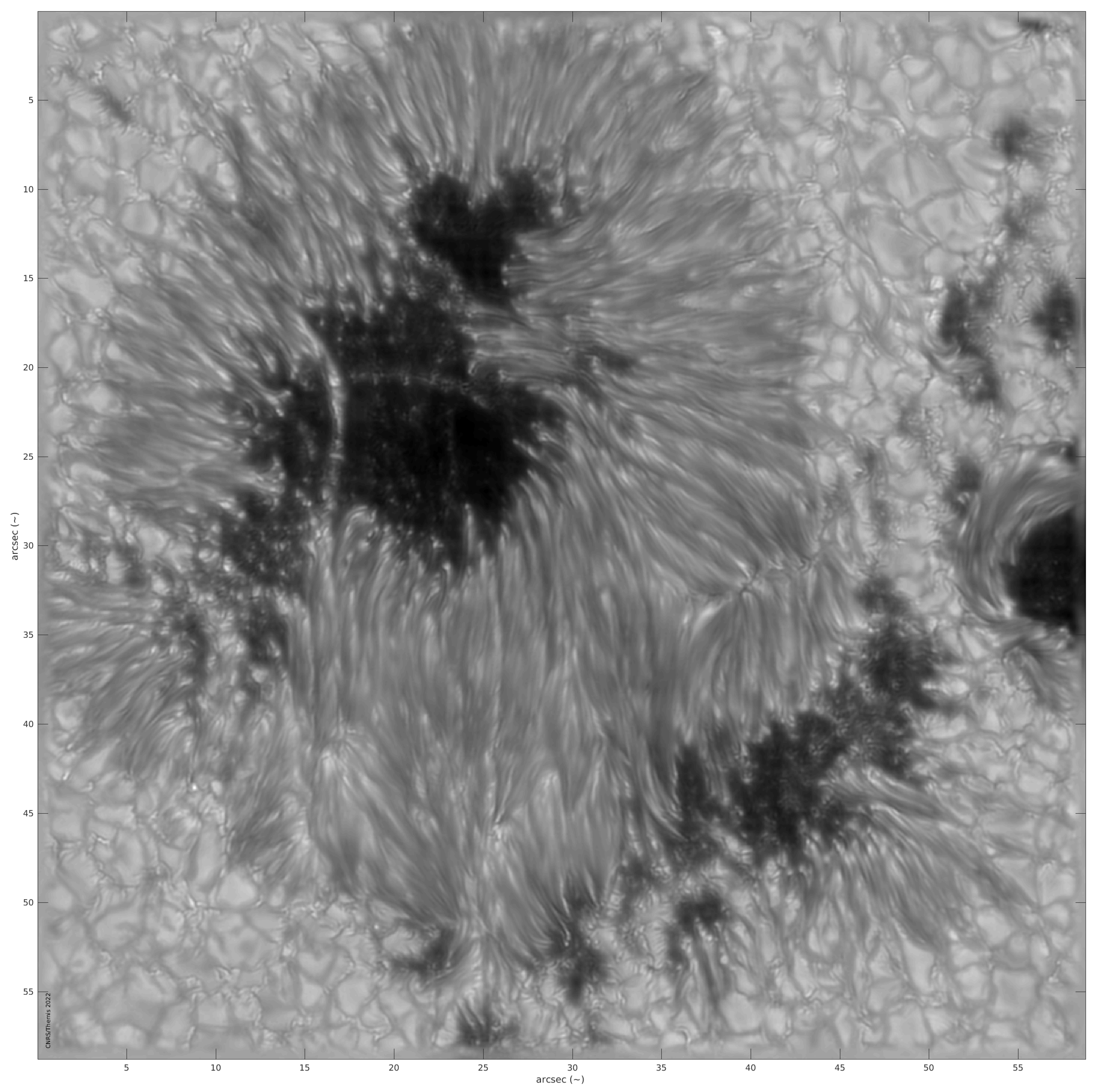
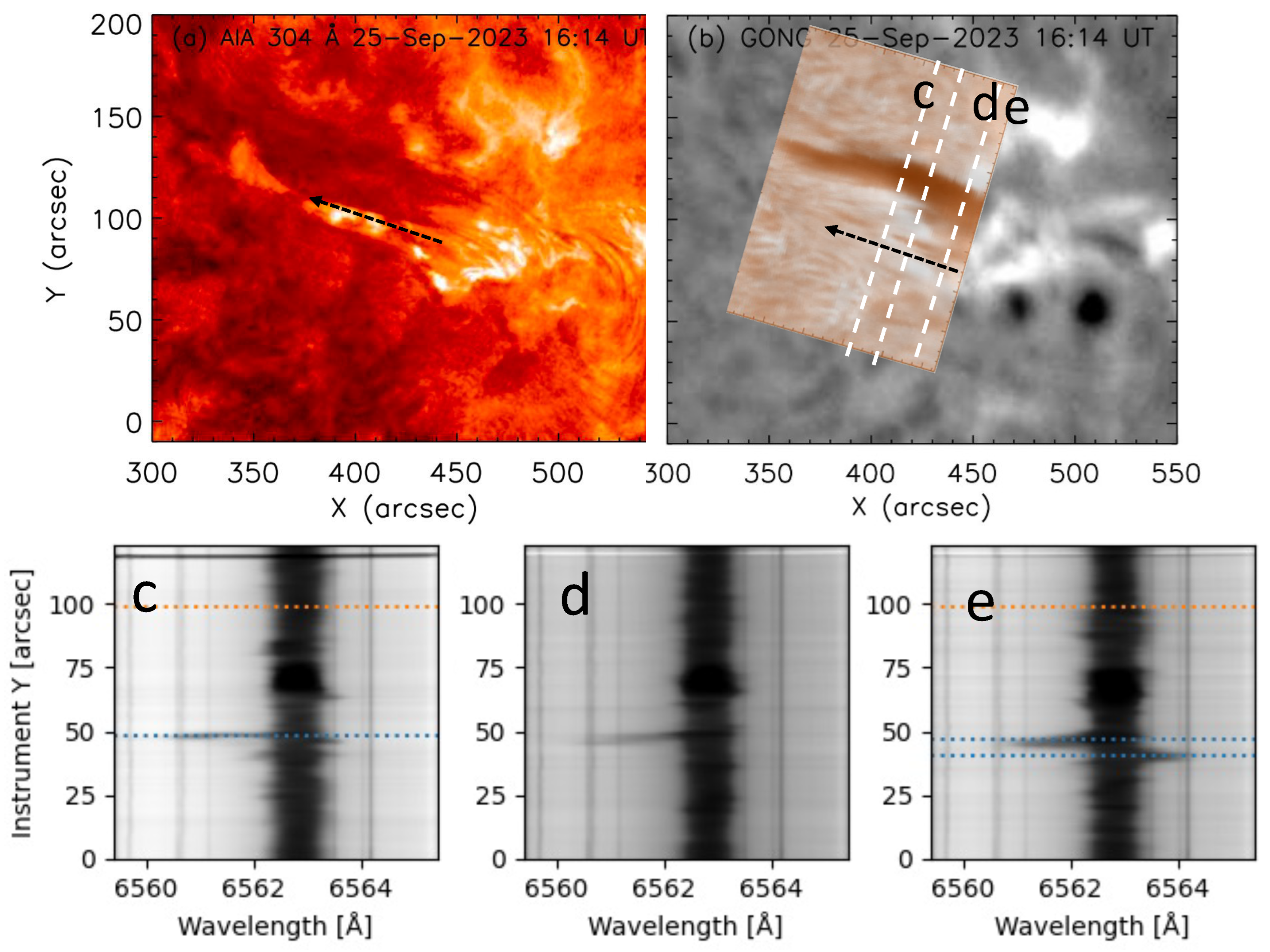
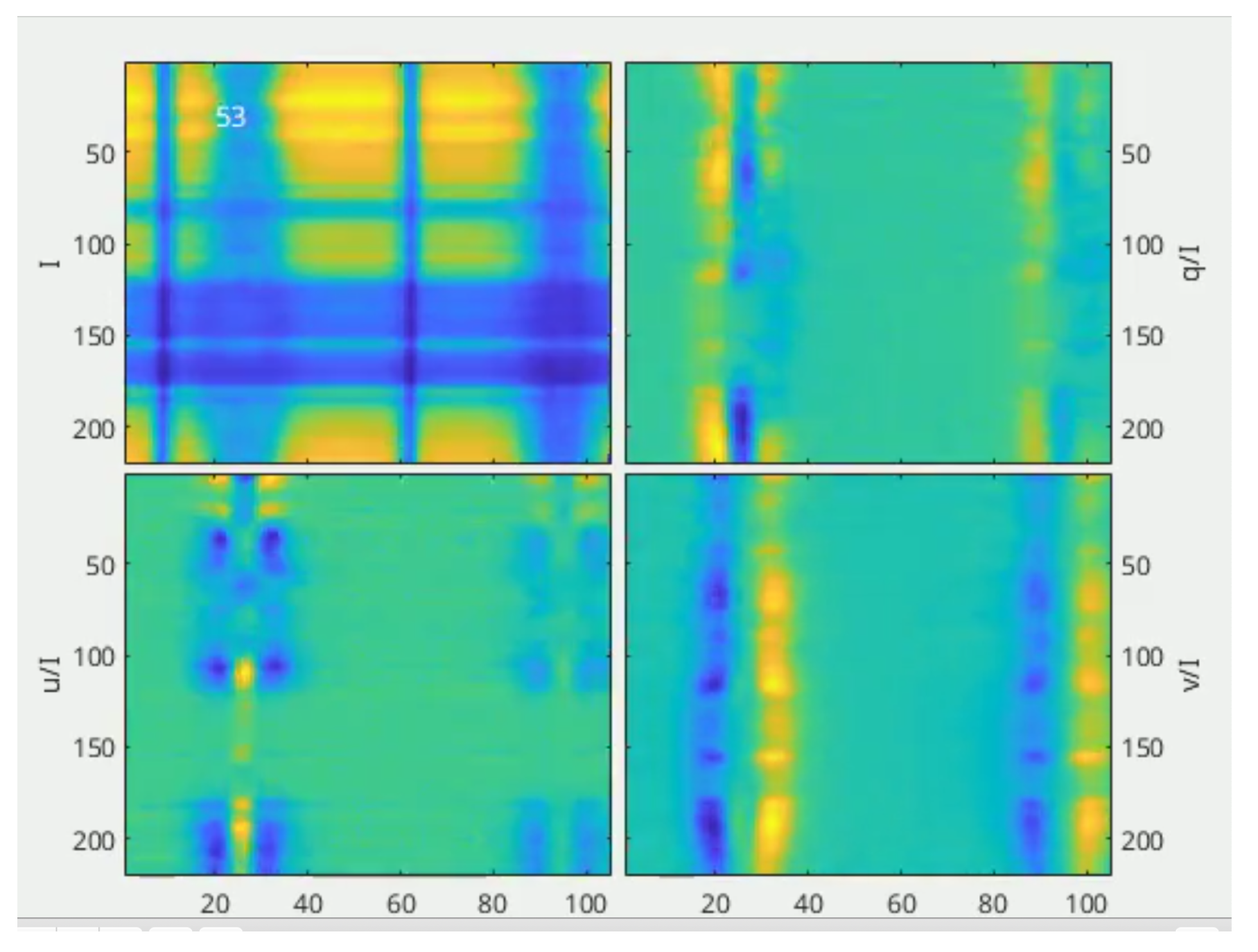
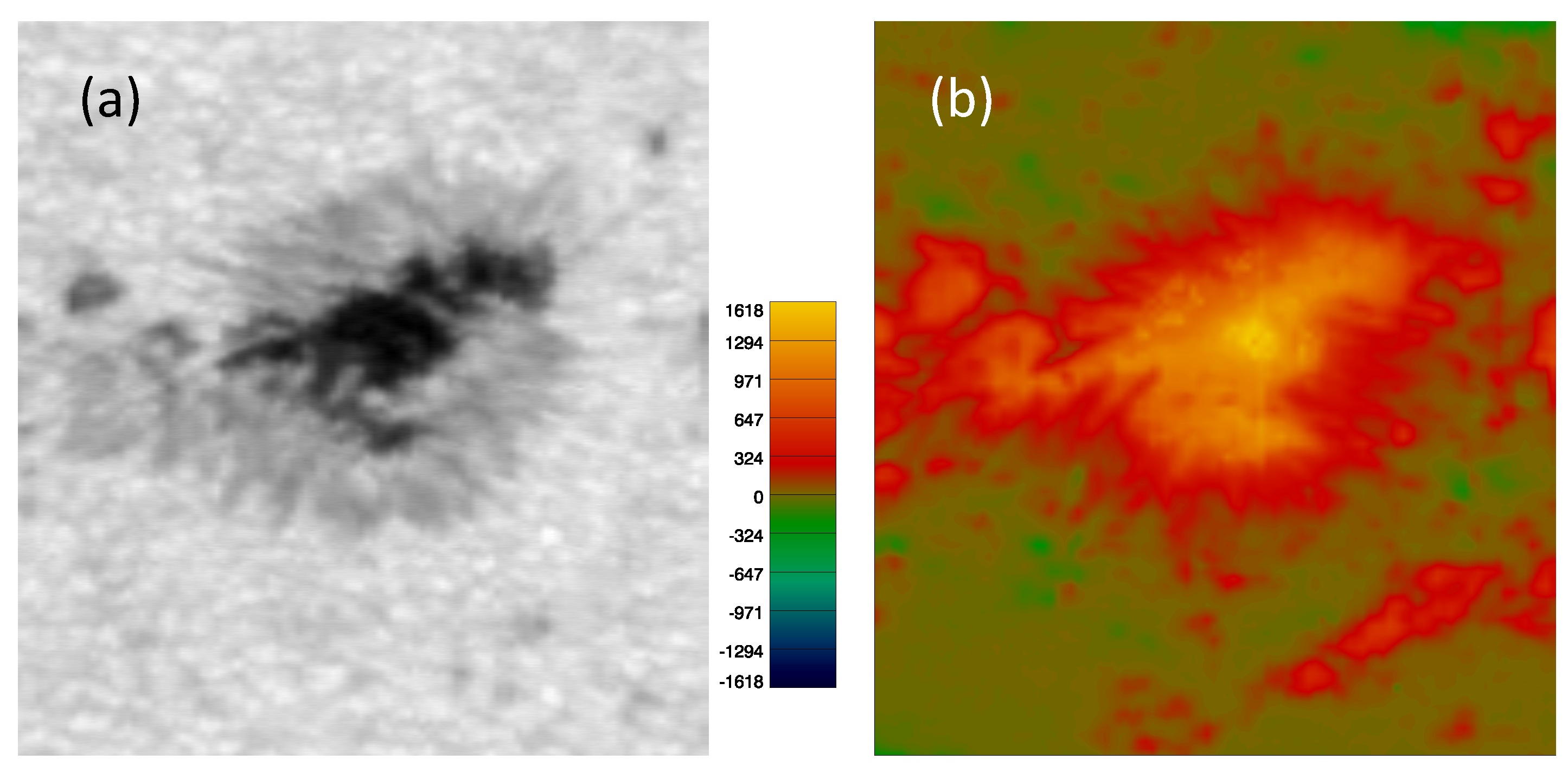
Disclaimer/Publisher’s Note: The statements, opinions and data contained in all publications are solely those of the individual author(s) and contributor(s) and not of MDPI and/or the editor(s). MDPI and/or the editor(s) disclaim responsibility for any injury to people or property resulting from any ideas, methods, instructions or products referred to in the content. |
© 2025 by the authors. Licensee MDPI, Basel, Switzerland. This article is an open access article distributed under the terms and conditions of the Creative Commons Attribution (CC BY) license (https://creativecommons.org/licenses/by/4.0/).
Share and Cite
Schmieder, B.; Bommier, V.; Gelly, B. THEMIS Vector Magnetograph in Canary Islands. Universe 2025, 11, 153. https://doi.org/10.3390/universe11050153
Schmieder B, Bommier V, Gelly B. THEMIS Vector Magnetograph in Canary Islands. Universe. 2025; 11(5):153. https://doi.org/10.3390/universe11050153
Chicago/Turabian StyleSchmieder, Brigitte, Véronique Bommier, and Bernard Gelly. 2025. "THEMIS Vector Magnetograph in Canary Islands" Universe 11, no. 5: 153. https://doi.org/10.3390/universe11050153
APA StyleSchmieder, B., Bommier, V., & Gelly, B. (2025). THEMIS Vector Magnetograph in Canary Islands. Universe, 11(5), 153. https://doi.org/10.3390/universe11050153








